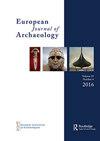伊比利亚北部梅塞塔铁器时代晚期妇女透视
IF 1.4
2区 历史学
0 ARCHAEOLOGY
引用次数: 1
摘要
铁器时代晚期传统上被描绘成一个剑、凯尔特图案盾牌和青铜大锅的时代,一个战争、宴会和突袭的时代,主要是男性战士。但是对于其他人,尤其是女性,我们知道些什么呢?基于同样的数据,是否有可能发现另一种包括女性在内的叙事?本文主要关注伊比利亚北部的梅塞塔地区,这是一个有着悠久研究传统的地区,在铁器时代的记载中,妇女几乎是看不见的。根据一系列考古和文本证据,本研究将女性的角色置于最前沿,对传统研究话语进行了批判,并从性别包容的角度讨论了铁器时代社会的运作方式。本文章由计算机程序翻译,如有差异,请以英文原文为准。
A Perspective on Late Iron Age Women in the Iberian Northern Meseta
The Late Iron Age has traditionally been portrayed as an age of swords, Celtic-patterned shields, and bronze cauldrons, a time of warfare, banquets, and raids, mostly starring male warriors. But what do we know about the rest of the population, especially women? Is it possible, based on the same data, to uncover an alternative narrative that includes women? This article focuses on the northern Meseta of Iberia, an area with a long research tradition, in which women are almost invisible in accounts of the Iron Age. Drawing on a range of archaeological and textual evidence, this study brings the roles of women to the forefront, offering a critique of traditional research discourses and a discussion on how Iron Age societies worked from a gender-inclusive perspective.
求助全文
通过发布文献求助,成功后即可免费获取论文全文。
去求助
来源期刊

European Journal of Archaeology
ARCHAEOLOGY-
CiteScore
3.40
自引率
6.70%
发文量
58
期刊介绍:
The publication organ of the European Association of Archaeologists, the European Journal of Archaeology seeks to promote open debate amongst archaeologists committed to a new idea of Europe in which there is more communication across national frontiers and more interest in interpretation. The journal accepts not only new empirical data and new interpretations of the past but also encourages debate about the role archaeology plays in society, how it should be organized in a changing Europe, and the ethics of archaeological practice. All periods are covered; papers, review articles, interviews and short "debate" pieces are all sought. Whilst English is the primary language of publication in the EJA, papers submitted in French or German will be given equal consideration.
 求助内容:
求助内容: 应助结果提醒方式:
应助结果提醒方式:


